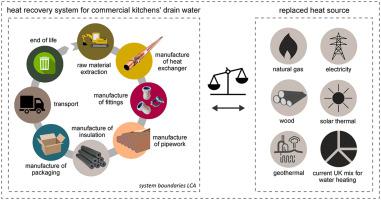Journal of Environmental Management ( IF 8.7 ) Pub Date : 2020-06-26 , DOI: 10.1016/j.jenvman.2020.110988 Isabel Schestak 1 , Jan Spriet 2 , David Styles 3 , A Prysor Williams 1

|
Although the food service sector is a major user of water, the potential for heat recovery from commercial kitchens’ drain water remains largely unexplored. For the first time, we compare the life cycle environmental burdens of producing and installing a heat recovery system with the environmental credits arising from energy savings for a restaurant case study, and for the entire UK food service sector. Life Cycle Assessment was applied to determine the impacts of heat recovery systems made from different materials and comprising a heat exchanger in the shape of a concentric double-walled pipe, pipework and fittings. The design option with the smallest environmental footprint combined a heat exchanger made out of polypropylene-graphite (PP-GR) with polyethylene pipework, exhibiting 80–99% less environmental impact compared with components made out of (35% recycled) copper. Contrasting the environmental impacts of two heat recovery set-ups with energy savings shows that a PP-GR based system pays back all burdens of the seven assessed environmental impact categories, within two years, while payback times for the copper-based system vary depending on the replaced energy source, and can exceed the 10 year operational lifetime of the system. When looking at typical flow-rates in UK food outlets, net environmental savings can be realised across all analysed impact categories above a threshold water consumption of 555 L/day, using current technology. Extrapolation to the UK food service sector indicates annual greenhouse gas emission mitigation potential of about 500 Gg CO2 equivalent.
中文翻译:

排放量低:通过使用厨房排水管的热量回收资源来平衡生命周期的能源和温室气体节省。
尽管食品服务部门是用水的主要用户,但商用厨房的排热回收热量的潜力仍未开发。我们首次将生产和安装热回收系统的生命周期环境负担与餐馆案例研究以及整个英国餐饮服务部门因节约能源而产生的环境信用进行了比较。生命周期评估用于确定由不同材料制成的热回收系统的影响,该系统包括同心双壁管,管道和配件形状的热交换器。具有最小环境足迹的设计选项结合了由聚丙烯-石墨(PP-GR)制成的热交换器和聚乙烯管道,与由(35%回收)铜制成的组件相比,对环境的影响要少80–99%。将两种热回收装置的环境影响与节能进行对比,结果表明,基于PP-GR的系统可在两年内偿还七种评估的环境影响类别的所有负担,而铜基系统的投资回报时间因更换的能源,并且可能超过系统的10年使用寿命。当查看英国食品商店的典型流量时,使用当前技术,可以在所有分析的影响类别中实现超过555 L /天的阈值耗水量以上的净环境节省。外推至英国食品服务业表明,每年可减少约500 Gg CO的温室气体排放 将两种热回收装置的环境影响与节能进行对比,结果表明,基于PP-GR的系统可在两年内偿还七种评估的环境影响类别的所有负担,而铜基系统的投资回报时间因更换的能源,并且可能超过系统的10年使用寿命。当查看英国食品商店的典型流量时,使用当前技术,可以在所有分析的影响类别中实现超过555 L /天的阈值耗水量以上的净环境节省。外推至英国食品服务业表明,每年可减少约500 Gg CO的温室气体排放 将两种热回收装置的环境影响与节能进行对比,结果表明,基于PP-GR的系统可在两年内偿还七种评估的环境影响类别的所有负担,而铜基系统的投资回报时间因更换的能源,并且可能超过系统的10年使用寿命。当查看英国食品商店的典型流量时,使用当前技术,可以在所有分析的影响类别中实现超过555 L /天的阈值耗水量以上的净环境节省。外推至英国食品服务业表明,每年可减少约500 Gg CO的温室气体排放 而铜基系统的投资回收期取决于所更换的能源,并且可能超过系统的10年使用寿命。当查看英国食品商店的典型流量时,使用当前技术,可以在所有分析的影响类别中实现超过555 L /天的阈值耗水量以上的净环境节省。外推至英国食品服务业表明,每年可减少约500 Gg CO的温室气体排放 而铜基系统的投资回收期取决于所更换的能源,并且可能超过系统的10年使用寿命。当查看英国食品商店的典型流量时,使用当前技术,可以在所有分析的影响类别中实现超过555 L /天的阈值耗水量以上的净环境节省。外推至英国食品服务业表明,每年可减少约500 Gg CO的温室气体排放2当量。



























 京公网安备 11010802027423号
京公网安备 11010802027423号